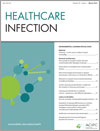
Healthcare Infection
Volume 18 Number 1 2013
Environmental Cleaning
HI12063How quickly do hospital surfaces become contaminated after detergent cleaning?
No one knows how best to clean a hospital in order to protect patients from infection. This study measured the effect of cleaning near-patient surfaces with detergent wipes on a busy ward. The wipes reduced the level of microbes on surfaces for at least 24 hours, including S. aureus and MRSA. It was concluded that physical removal using detergent wipes can control microbial contamination at high-risk sites.
HI12063 Abstract | HI12063 Full Text | HI12063PDF (224 KB) Open Access Article
HI12049Observations on hospital room contamination testing
Infections are a major complication of hospitalisation, but techniques for measuring cleanliness of the hospital environment are not standardised. We found that hospital surfaces vary widely in their level of contamination, but that very few had hazardous organisms. There is a need for better understanding of the methods for testing environmental cleanliness, including comparison of ATP detection and quantitative microbiology.
HI12057Role of the hospital environment in disease transmission, with a focus on Clostridium difficile
Contamination of the surface environment in hospital rooms plays an important role in the transmission of several key healthcare-associated pathogens including Clostridium difficile. Effective prevention strategies for C. difficile include antibiotic stewardship, thorough cleaning and disinfection of the patient’s environmental daily and at discharge (terminal cleaning/disinfection), and use of contact isolation for patients with C. difficile infection.
HI12057 Abstract | HI12057 Full Text | HI12057PDF (184 KB) Open Access Article
HI12047Methods to evaluate environmental cleanliness in healthcare facilities
Consistent accurate methods to evaluate environmental cleanliness are required to evaluate cleaning interventions and support quality improvement activities. This review explores and evaluates methods used to evaluate cleaning in healthcare facilities. Fast, reproducible and cost effective methods are needed for routine environmental cleaning.
HI12054Surface cleaning and disinfection: insight into the situation in Germany and Europe
Surface disinfectant constitutes a basic prevention strategy in hospital hygiene. Cleaning procedures using only detergents, especially for areas with frequent hand and skin contact, are inadequate. They often lead to insufficient inactivation and spread of facultative pathogens. The ‘Hygiene Requirements for the Cleaning and Disinfection of Surfaces’ recommendations of KRINKO combined with quality assurance via the VAH disinfectant list guarantee safe surface disinfection practise.
HI12041Cleaning and disinfection in outbreak control – experiences with different pathogens
Outbreaks of nosocomial infections are common problems in hospitals and need a multidisciplinary approach. Two cases of infections with K. pneumonia and VRE respectively are described in a tertiary care hospital and their handling demonstrated in a standardised procedure including a change in the cleaning process. Pathogen transmission could be stopped in both outbreaks indicating the importance of the cleaning concept.

